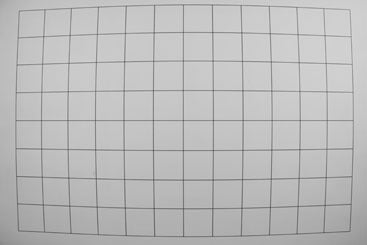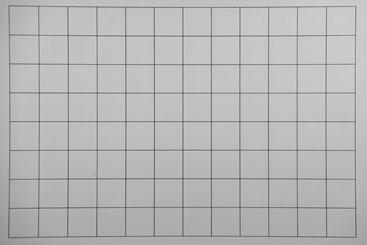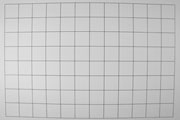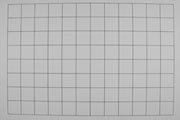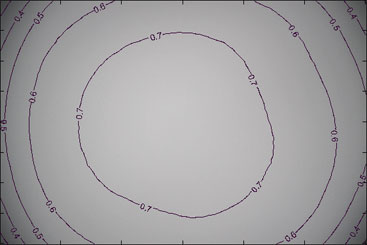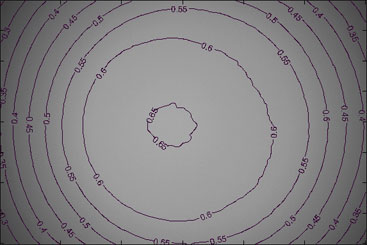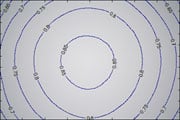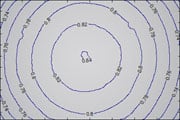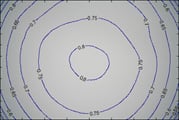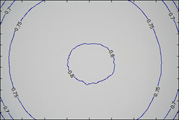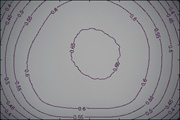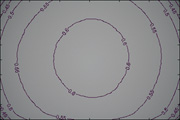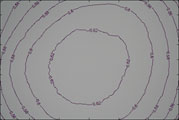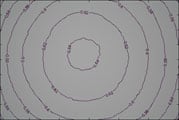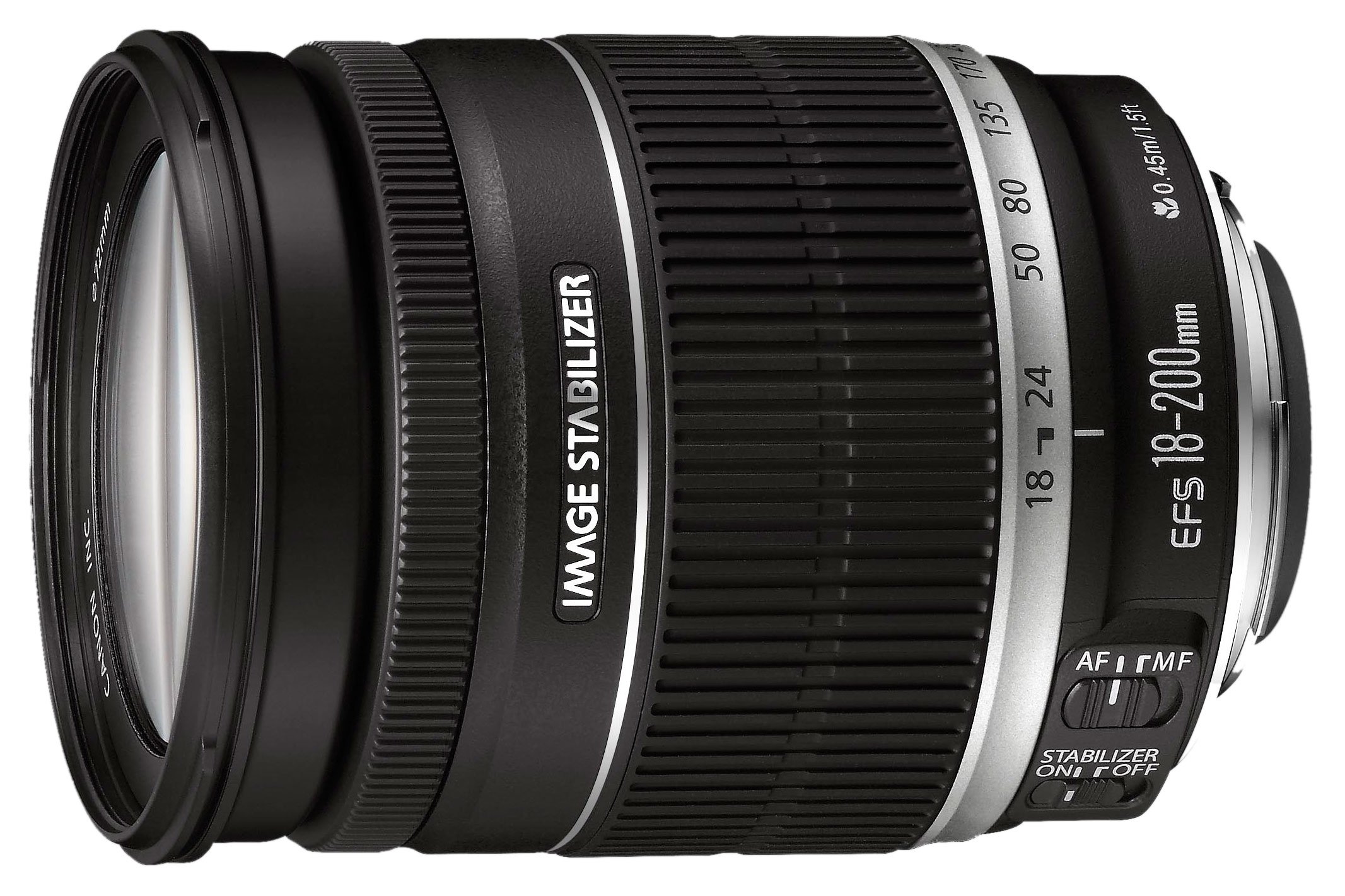
Canon EF-S 18-200mm f3.5-5.6 IS
-
-
Written by Gordon Laing
Quality
The Canon EF-S 18-200mm IS is pictured below on the far right, with the EF-S 18-55mm IS kit lens on the left and the EF-S 17-85mm IS in the middle. Measuring 102mm in length with a maximum diameter of 79mm, Canon’s super-zoom is clearly larger than the 92x78mm of the EF-S 17-85mm IS, although a little smaller than the 111x84mm of the EF-S 17-55mm f2.8 IS.
In terms of weight, the EF-S 18-200mm IS is heavier than it looks at 595g; this places it closer to the 645g heft of the optically bright EF-S 17-55mm f2.8 and comfortably more than the 475g of the EF-S 17-85mm IS. If you’re used to the EF-S 18-55mm IS, almost anything you fit will feel large and heavy as the kit model weighs just 200g.
In terms of design, the EF-S 18-200mm is a departure from existing Canon EF-S general purpose models, looking and feeling closer to the recent EF-S 55-250mm IS telephoto zoom. The build quality is also roughly in the middle of the EF-S range, so while a step-up from the EF-S 18-55mm IS kit lens, it’s not up to the EF-S 17-55mm IS.
There’s a metal lens mount, but like other models of its class, sadly no rubber environmental sealing. Unlike both the EF-S 17-85mm IS and EF-S 17-55mm IS, there’s also no window indicating focusing distance. As mentioned above though, the lens is heavier than it looks, which lends it an air of greater confidence.
In use, your left hand naturally supports the lens on its wide zoom ring, which when turned to the maximum 200mm focal length extends the barrel in two sections by 60mm. Our sample suffered from a little creep between focal lengths of 80 and 35mm, where the lens could gradually retract or extend under its own weight when pointed vertically up or down respectively. We have a demonstration of this in our video tour.
Our lens was also a new sample, so this could become looser over time, although to be fair we’ve also experienced creep with the Nikkor 18-200mm VR and this has varied between samples. To prevent the Canon’s barrel from extending when not in use though, a small switch can lock it at the 18mm position.
| A quick note about using the popup flash with the EF-S 18-200mm IS. We tried it with the EOS 450D and EOS 50D bodies and found a tiny shadow was cast by the lens barrel when fully zoomed-out. It’s fairly minimal though, and disappears when the lens is zoomed-into just 20mm or beyond. As such, you’re unlikely to notice it when using the built-in flash, but to be sure, just twist the dial slightly. |
Canon EF-S 18-200mm IS optical design notes
The Canon EF-S 18-200mm IS employs 16 elements in 12 groups, including UD glass and aspherical lenses. The focal ratio is f3.5 when zoomed-out to 18mm and f5.6 when zoomed-into 200mm. The closest focusing distance is 45cm and we have an example in our sample images gallery.
Canon EF-S 18-200mm IS focusing
Towards the end of the lens barrel you’ll find a narrow manual focusing ring. This feels similar in use to those on other EF-S lenses, although annoyingly the absence of full-time manual focusing means you’ll need to switch the lens from AF to MF before you can turn it. The manual focusing ring also turns while the lens auto-focuses, although this isn’t as big a deal as it sounds as your grip is normally much further back on the zoom ring. At the end of the barrel is a 72mm filter thread, which thankfully remains static during the auto-focus process – good news for users of polarising and other directional filters.
 |
Canon’s encyclopaedic Lens Work book states the company intends to eventually equip all its lenses with quick and quiet USM focusing motors, so it’s a surprise and disappointment not to find one here. Despite its not insignificant price tag, the EF-S 18-200mm IS is auto-focused by a gear-driven DC motor which is quite audible in practice – you can hear it in our video tour – and again you need to disengage it to manually focus.
To be fair though, the EF-S 18-200mm IS can be quite swift at focusing. The lens can rapidly focus from one end of its range to the other and we didn’t find any situations where its focusing was insufficiently quick to keep up with moving subjects – this included our standard DSLR auto-focusing test where we track vehicles approaching face-on at 50kph.
So in terms of speed we have no complaints with the EF-S 18-200mm IS, but every time you hear the gears grind or are prevented from tweaking the manual focus ring without first flicking a switch, you curse Canon for not equipping it with USM. It’s a bizarre decision, especially when the similarly-priced Nikkor DX 18-200mm VR features one of the company’s SWM focusing systems.
Now let’s take a look at the coverage and stabilisation in our Canon EF-S 18-200mm IS features page.
Canon EF-S 18-200mm IS coverage
Canon’s EF-S 18-200mm IS is designed as a powerful all-round lens with an 11.1x super-zoom range. With the 1.6x field-reduction factor of Canon’s APS-C DSLRs, the EF-S 18-200mm IS delivers equivalent coverage of 29-320mm, taking you from wide angle all the way to pretty respectable telephoto coverage. To illustrate this significant range in practice we mounted the lens on an EOS 50D body, attached it to a tripod and shot the same scene fully zoomed-out, then fully zoomed-in.
Canon EF-S 18-200mm IS coverage | ||
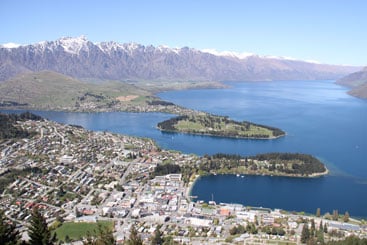 | 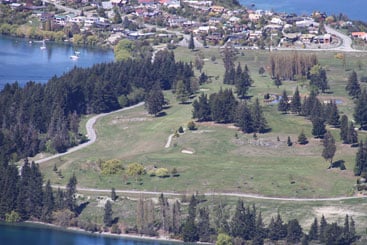 | |
EF-S 18-200mm at 18mm (29mm equivalent) | EF-S 18-200mm at 200mm (320mm equivalent) | |
It’s clear from the images above the degree of flexibility such a lens provides. You could be shooting an expansive landscape at one moment, spot an unusual bird or animal in the distance and within a second or two twist the zoom ring around to capture a tight close-up view. Such a range is equally useful when shooting in urban environments, allowing you to capture wide architectural views, before zooming-in for some interesting street shots. Suffice it to say the ability to zoom from wide to decent telephoto is also ideal when you’re attending weddings or sporting events.
Of course you can achieve the same range with multiple lenses, and also generally enjoy superior performance while you’re at it, but the convenience of having it all in one lens cannot be underestimated. You don’t need to lug multiple lenses around with you, waste time changing them while running the risk of missing your photo opportunity, and of course by not removing lenses, you’ll also minimise the risk of dust entering the body. All these reasons make super-zooms ideal for travel photography, and are responsible for existing models from rival manufacturers topping the best-seller lists.
Once again, going for multiple lenses provides the opportunity to buy specialist models which may be wider, longer, sharper, brighter or quicker, but for many people, a 29-320mm equivalent range could be all they ever need. It’s certainly a compelling prospect.
Canon EF-S 18-200mm IS stabilisation
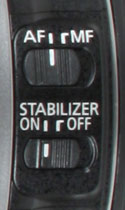 |
The Canon EF-S 18-200mm IS is equipped with Image Stabilisation to counteract camera shake. Like all of Canon’s IS lenses to date, this employs an optical system which means you see the stabilising effect while composing through the optical viewfinder. Seeing the image suddenly steady itself when you half-press the shutter release button is very reassuring, especially when you’re shooting at longer focal lengths.
IS is enabled by flicking a switch on the side of the lens barrel. Canon claims the lens has four stops of compensation and automatically detects any panning movement to temporarily deactivate one axis. To put its effectiveness to the test we took a series of photos with it zoomed-into an equivalent of 320mm, where traditional photographic advice would recommend a shutter speed of at least 1/320 to eliminate camera shake.
Our sequence therefore started at 1/320 and reduced by one stop each time until 1/5. We performed this sequence twice, first without IS enabled, and secondly with IS enabled. Below are 100% crops taken from the non-IS and IS images at a shutter speed of 1/20.
Canon EF-S 18-200mm IS Image Stabilisation off / on | ||
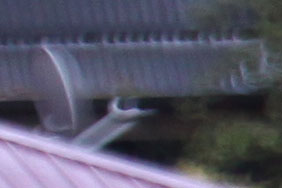 | 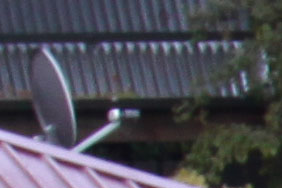 | |
100% crop, EF-S 18-200mm IS at 200mm, 1/20, IS off | 100% crop, EF-S 18-200mm IS at 200mm, 1/20, IS on | |
The fastest we could handhold a sharp result when fully zoomed-in without any stabilisation was at 1/160; anything slower than this suffered from camera shake. With IS enabled though, we could match the sharpness under the same conditions at a shutter speed of 1/20. You can see examples taken at 1/20 with and without stabilisation above, and it’s clear how the version with IS is much steadier.
This corresponds to three stops in practice over our 1/160 shot, or four stops over conventional wisdom at 1/320. So while we didn’t quite achieve four stops in person, having three at your disposal is still very respectable and makes the EF-S 18-200mm IS usable in a variety of environments even when fully zoomed-in. Just remember though, image stabilisation cannot do anything about freezing a subject in motion – for that you’ll simply need a sufficiently quick shutter speed.
Now it’s time to see how the lens performs against alternative general purpose zooms in our Canon EF-S 18-200mm IS results pages.
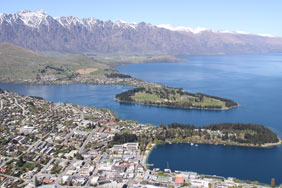
To compare real-life performance we shot this scene with the Canon EF-S 18-200mm IS, EF-S 17-85mm IS and EF-S 18-55mm IS, all mounted on the same EOS 50D body within moments of each other. The EOS 50D was set to its best quality JPEG setting, lowest 100 ISO sensitivity and default processing options.
The lenses on each camera were adjusted to deliver the same field of view, and set to f8 in Aperture Priority mode. IS was disabled on each lens, and magnified assistance in Live View used to confirm the focusing.
The image above was taken with the Canon EF-S 18-200mm IS mounted on the Canon EOS 50D body. The lens was set to 24mm f8, and the 50D set to 100 ISO. The exposures were identical with each lens (1/250 at f8) and the crops are taken from the upper left, centre, lower right and left of centre, and are presented here at 100%.
At first glance, the first row of crops, taken from the upper left corner of the image, all appear similar, with all suffering from some visible coloured fringing. Look a little closer though and you’ll see differences in the actual colour of that fringing, with the three lenses from left to right exhibiting light red, pink and darker red fringing respectively. To our eyes, the fringing on the EF-S 18-55mm IS is the least offensive, but there’s not much in it. The good news is Digital Photo Professional can do a good job at removing these from RAW files. Staying with this cropped area, the EF-S 18-55mm IS has a slight edge in sharpness, while the EF-S 18-200mm IS is fractionally softer than the others, but it’s a pretty subtle difference.
Moving onto the second row of crops taken from just above the middle of the image again shows three very similar-looking results. There’s little to choose between them here, although again the EF-S 18-55mm IS has a very slight edge in terms of contrast and definition – but again this is serious pixel-peeping.
The third row of crops once again look very similar, all suffering from some softness, with only subtle clues like the colour of the fringing to tell them apart. When evaluating the broader area around these crops though, the EF-S 17-85mm IS enjoyed a slight edge in overall sharpness, with some of the details on the other two models becoming a little softer.
The fourth and final row of crops again look almost identical at first glance, although as above, evaluating a larger area around the cropped portion reveals a slight advantage to the EF-S 17-85mm IS in terms of definition, but again this is very subtle.
So closed to f8, all three lenses perform similarly at this focal length, with little to tell them apart beyond the colour of their high contrast fringing. The EF-S 18-200mm IS may have been a tad softer overall than the others, but it was certainly subtle. We have further real-life comparisons though at their shortest and longest focal lengths and at wider apertures, so to see how the lenses measure-up under these conditions, let’s move onto our Real-life Corner sharpness results.
Canon EF-S 18-200mm IS with Canon EOS 50D | Canon EF-S 17-85mm IS with Canon EOS 50D | Canon EF-S 18-55mm IS with Canon EOS 50D | ||
 |  |  | ||
f8, 100 ISO | f8, 100 ISO | f8, 100 ISO | ||
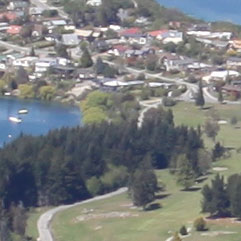 | 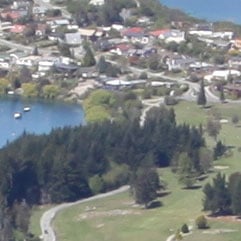 | 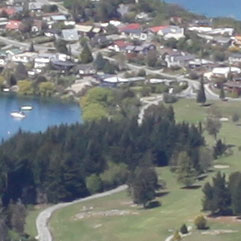 | ||
f8, 100 ISO | f8, 100 ISO | f8, 100 ISO | ||
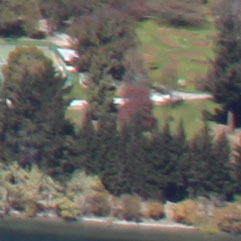 | 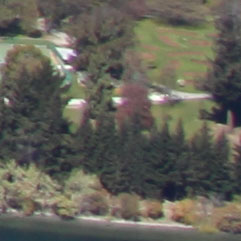 | 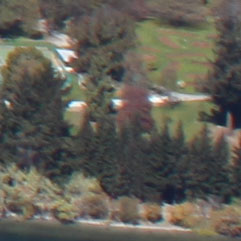 | ||
f8, 100 ISO | f8, 100 ISO | f8, 100 ISO | ||
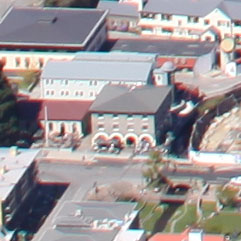 | 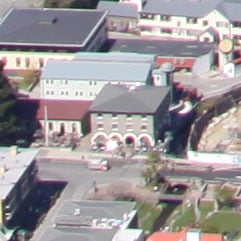 | 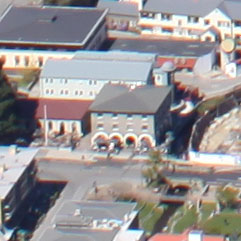 | ||
f8, 100 ISO | f8, 100 ISO | f8, 100 ISO |
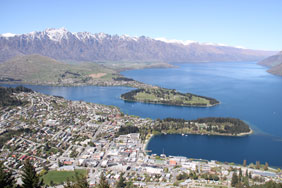
To compare real-life corner sharpness when zoomed-out, we shot this scene with the Canon EF-S 18-200mm IS and EF-S 18-55mm IS, both mounted on the same EOS 50D body within moments of each other; a fault with our EF-S 17-85mm IS at 17mm prevented it from being included on this page. The EOS 50D was set to its best quality JPEG setting, lowest 100 ISO sensitivity and default processing options.
Both lenses were zoomed-out to their widest 18mm focal lengths and tested at all aperture settings. IS was disabled on each lens, and magnified assistance in Live View used to confirm the focusing.
The image above was taken with the Canon EF-S 18-200mm IS mounted on the Canon EOS 50D body. The lens was set to 18mm f8, and the 50D set to 100 ISO. The crops are taken from the lower left corner and presented here at 100%.
On the previous page it was often hard to see any difference between the lenses at 24mm f8, but here the crops tell a quite different story. With both lenses zoomed-out to their widest 18mm, the corner performance of the EF-S 18-200mm IS is comfortably beaten by the budget EF-S 18-55mm IS kit lens. Both lenses may visibly improve as their apertures are gradually closed, but it doesn’t take a pixel-peeper to see the EF-S 18-55mm IS starts off looking much better – indeed wide-open at f3.5 it’s performing surprisingly well considering its budget status. In contrast the EF-S 18-200mm IS looks noticeably softer with quite apparent red fringing.
The EF-S 18-200mm IS greatly improves beyond f5.6, but the EF-S 18-55mm IS remains superior throughout in this particular test. So does this softness on the EF-S 18-200mm IS only affect the corners when zoomed-out to 18mm? Find out by scrolling to the bottom of this page where you’ll find comparisons against its corner and centre performance. Alternatively if you’ve already seen enough, let’s zoom-in and move onto our Canon EF-S 18-200mm IS Real life corner results at telephoto.
Canon EF-S 18-200mm IS with Canon EOS 50D | Canon EF-S 18-55mm IS with Canon EOS 50D | |
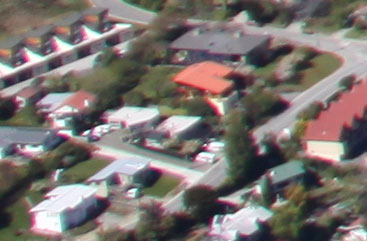 | 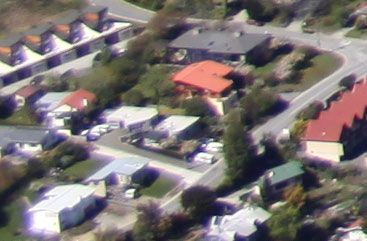 | |
f3.5, 100 ISO | f3.5, 100 ISO | |
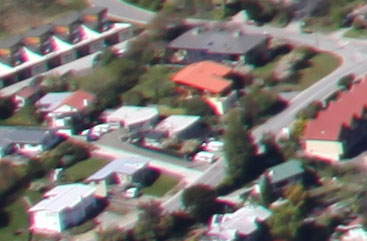 | 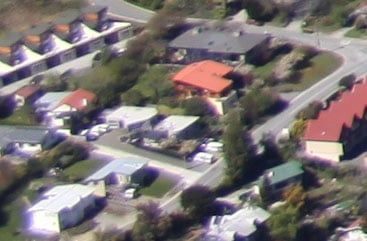 | |
f4, 100 ISO | f4, 100 ISO | |
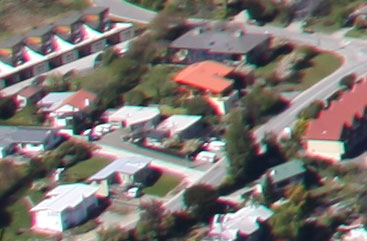 | 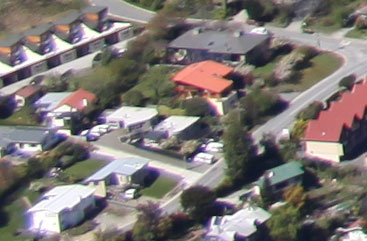 | |
f5.6, 100 ISO | f5.6, 100 ISO | |
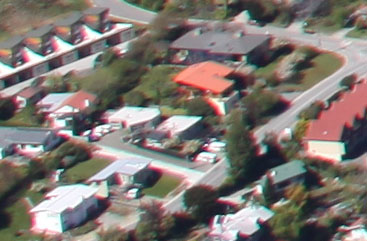 | 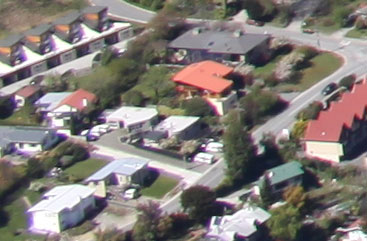 | |
f8, 100 ISO | f8, 100 ISO | |
Real-life corner vs centre sharpness at 18mm – Canon EF-S 18-200mm IS
The crops below are from the same series of images taken with the Canon EF-S 18-200mm IS mounted on the EOS 50D body and zoomed-out to 18mm – but this time we’ve taken crops from both the corner and the centre at different apertures to compare the differences.
Judging from the crops below, the EF-S 18-200mm IS suffers from softness across the frame when zoomed-out to 18mm and at large apertures. Again the situation greatly improves at f5.6 and beyond, but for the best results, you’ll want to avoid using the EF-S 18-200mm IS between f3.5 and f5.6 when zoomed-out if possible. Now let’s zoom-in and move onto our Canon EF-S 18-200mm IS Real life corner results at telephoto.
Canon EF-S 18-200mm IS with Canon EOS 50D Wide (18mm) corner | Canon EF-S 18-200mm IS with Canon EOS 50D Wide (18mm) centre | |
 |  | |
f3.5, 100 ISO | f3.5, 100 ISO | |
 | 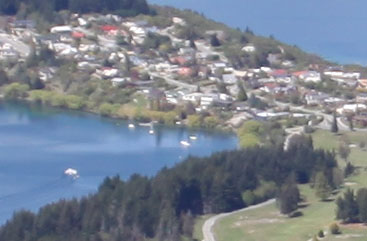 | |
f4, 100 ISO | f4, 100 ISO | |
 | 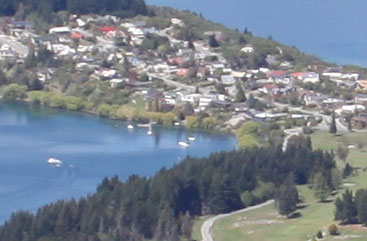 | |
f5.6, 100 ISO | f5.6, 100 ISO | |
 | 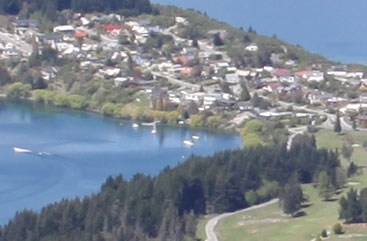 | |
f8, 100 ISO | f8, 100 ISO | |
Real-life corner vs centre sharpness at 200mm – Canon EF-S 18-200mm IS
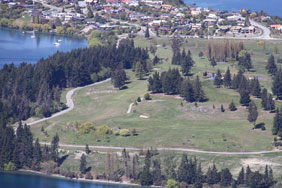
To compare real-life corner sharpness when zoomed-in, we shot this scene with the Canon EF-S 18-200mm IS on the EOS 50D body. The EF-S 18-200mm IS was zoomed-into its maximum 200mm focal length and tested at all aperture settings. The EOS 50D was set to its best quality JPEG setting, lowest 100 ISO sensitivity and default processing options.
IS was disabled and magnified assistance in Live View used to confirm the focusing. We have results for the EF-S 17-85mm IS and EF-S 18-55mm IS further down the page.
The image above was taken with the Canon EF-S 18-200mm IS mounted on the Canon EOS 50D body. The lens was set to 200mm f8, and the 50D set to 100 ISO. The crops are taken from the upper right corner and centre of the image, and presented here at 100%.
Zoomed-into its longest 200mm focal length and with the aperture wide-open at f5.6, the EF-S 18-200mm IS delivers a sharp detailed result in the centre of the frame, but is suffering from softness and fringing in the extreme corners.
As we saw on the previous page, the situation improves as you stop the lens down. The second row of crops taken at f8 show a noticeable improvement in the corner result over that at f5.6, although it’s still far from pin-sharp. Pixel-peepers may notice a small drop in fine foliage detail in the centre crop at f8 compared f5.6, but most would accept that small loss for the bigger improvement in the corner. Like most super-zoom lenses, there’s also a lack of contrast when zoomed-in, with slightly flat-looking results that can benefit from a boost in software later.
But how does this compare to the EF-S 17-85mm IS and EF-S 18-55mm IS when they’re zoomed-in to the maximum focal lengths? Are they any sharper? Find out by scrolling down this page. Alternatively, to compare them under controlled conditions, head straight for our Canon EF-S 18-200mm IS studio resolution page.
Canon EF-S 18-200mm IS with Canon EOS 50D Telephoto (200mm) corner | Canon EF-S 18-200mm IS with Canon EOS 50D Telephoto (200mm) centre | |
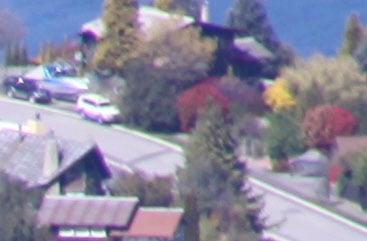 | 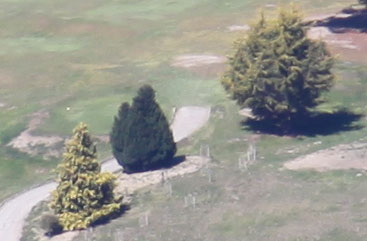 | |
f5.6, 100 ISO | f5.6, 100 ISO | |
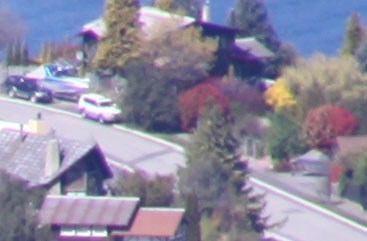 | 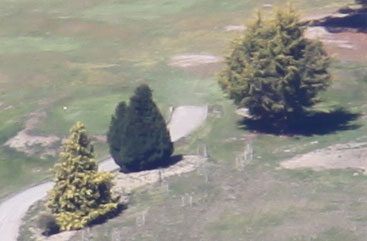 | |
f8, 100 ISO | f8, 100 ISO | |
Real-life corner vs centre sharpness at 85mm – Canon EF-S 17-85mm IS
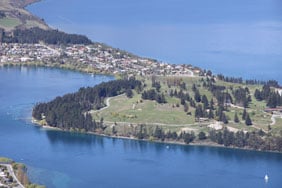
To compare real-life corner sharpness when zoomed-in, we shot this scene with the Canon EF-S 17-85mm IS on the EOS 50D body. The EF-S 17-85mm IS was zoomed-into its maximum 85mm focal length and tested at all aperture settings. The EOS 50D was set to its best quality JPEG setting, lowest 100 ISO sensitivity and default processing options.
IS was disabled and magnified assistance in Live View used to confirm the focusing.
The image above was taken with the Canon EF-S 17-85mm IS mounted on the Canon EOS 50D body. The lens was set to 85mm f8, and the 50D set to 100 ISO. The crops are taken from the lower left corner and centre of the image, and presented here at 100%.
Zoomed-into its longest 85mm focal length and with the aperture wide-open at f5.6, the EF-S 17-85mm IS delivers a detailed result in the centre of the frame, but like the super-zoom above, is suffering from softness and fringing in the extreme corners. That said, the result at f5.6 below left looks better than the corner result from the EF-S 18-200mm IS at the same aperture.
With the aperture closed to f8, the corner sharpness improves, as does the overall contrast and definition of the centre crop. So while the EF-S 17-85mm IS also suffers from softness in the corners at wide apertures when zoomed-in, it’s delivering a better result than the super-zoom – as indeed you’d expect given its shorter, less demanding optical range. Now scroll down a little further to see how the budget EF-S 18-55mm IS lens compares…
Canon EF-S 17-85mm IS with Canon EOS 50D Telephoto (85mm) corner | Canon EF-S 17-85mm IS with Canon EOS 50D Telephoto (85mm) centre | |
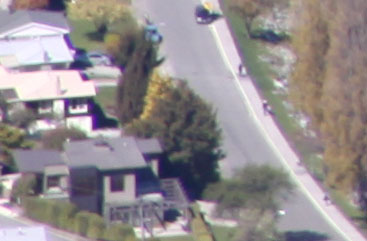 | 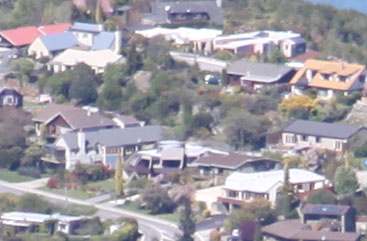 | |
f5.6, 100 ISO | f5.6, 100 ISO | |
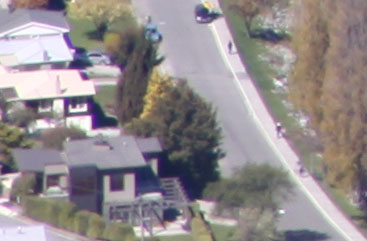 | 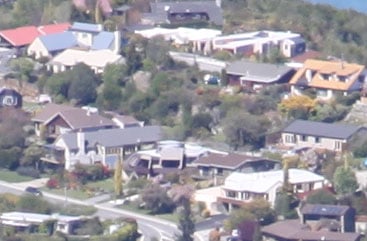 | |
f8, 100 ISO | f8, 100 ISO | |
Real-life corner vs centre sharpness at 55mm – Canon EF-S 18-55mm IS
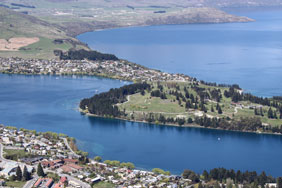
To compare real-life corner sharpness when zoomed-in, we shot this scene with the Canon EF-S 18-55mm IS on the EOS 50D body. The EF-S 18-55mm IS was zoomed-into its maximum 55mm focal length and tested at all aperture settings. The EOS 50D was set to its best quality JPEG setting, lowest 100 ISO sensitivity and default processing options.
IS was disabled and magnified assistance in Live View used to confirm the focusing.
The image above was taken with the Canon EF-S 18-55mm IS mounted on the Canon EOS 50D body. The lens was set to 55mm f8, and the 50D set to 100 ISO. The crops are taken from the lower left corner and centre of the image, and presented here at 100%.
Like the previous lenses, the EF-S 18-55mm IS exhibits some softness in the corners when zoomed-in with its aperture wide open, but judging from the crops below, it’s visibly sharper than either of the two pricier models.
The corner crop taken from the f5.6 sample is certainly soft, but looks better than the f5.6 corner crops from either the EF-S 17-85mm IS or EF-S 18-200mm IS. Close the lens to f8 and the corner result greatly improves, as does the contrast on the centre result. Overall, the EF-S 18-55mm IS is delivering the best optical results on this page, which is an impressive achievement considering its budget status – but of course it also has the shortest optical range of the three lenses here.
Ultimately this page illustrates the optical compromises involved with lenses sporting longer focal ranges. What you gain in convenience, you often lose in ultimate quality. Weighing this up is an entirely personal matter. But what about expressing actual resolving power numerically? Find out how the lenses compare in our Canon EF-S 18-200mm IS studio resolution page.
Canon EF-S 18-55mm IS with Canon EOS 50D Telephoto (55mm) corner | Canon EF-S 18-55mm IS with Canon EOS 50D Telephoto (55mm) centre | |
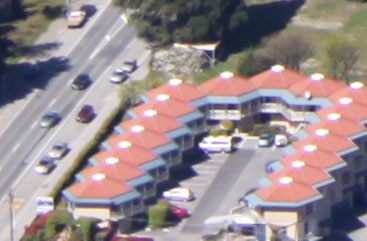 | 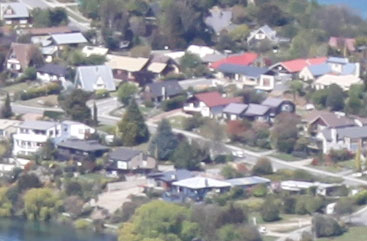 | |
f5.6, 100 ISO | f5.6, 100 ISO | |
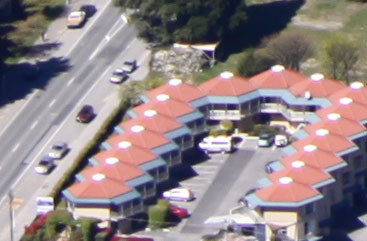 | 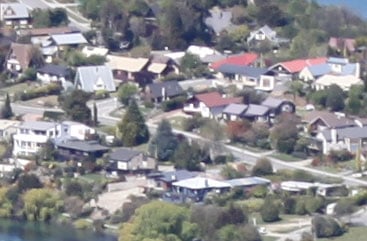 | |
f8, 100 ISO | f8, 100 ISO | |
Studio resolution: Canon EF-S 18-200mm IS using Canon EOS 50D
To measure and compare the Canon EF-S 18-200mm IS’s resolving power, we photographed the Enhanced Digital Camera Resolution Chart with it and a number of lenses, each set to 35mm f8 using a Canon EOS 50D in Aperture Priority mode. Magnified assistance in Live View was used to confirm the focusing.
The EOS 50D was set to RAW to maximise quality and avoid in-camera corrections, and the images converted using Digital Photo Professional 3.5 with its default settings.
The crops are taken from the converted RAW images, saved as High Quality JPEGs in Photoshop CS4 and presented here at 100%. Each number represents 100 lines per picture height (lpph), so a figure of 20 means a resolution of 2000 lpph.
Mounted on an EOS 50D body in RAW mode and set to 35mm f8, the Canon EF-S 18-200mm IS scored 2450 and 2400 lpph of horizontal and vertical resolution respectively. As you may expect, the EF-S 17-85mm IS scored slightly higher with 2500 lpph, and the EF 85mm prime slightly higher still with 2550 lpph. The surprise result here is for the EF-S 18-55mm IS lens which scored an impressive 2550 and 2500 lpph of horizontal and vertical resolution respectively, almost matching the performance of the prime lens in this test.
What comes as no surprise though is to find the EF-S 18-200mm IS resolving the least detail in this test. The massive 11.1x zoom range inevitably comes at the cost of some optical compromises, and as illustrated below, alternative lenses are required to enjoy the maximum detail from high resolution bodies like the EOS 50D.
But the EF-S 18-200mm IS does have sufficient quality to involve little or no resolution compromise for lower resolution Canon bodies, so if you were thinking of coupling it with an 8, 10 or even 12 Megapixel model, you shouldn’t worry about this particular test. The sheer convenience and flexibility of the super-zoom range will also see many owners of higher resolution bodies accept the compromises. But be in no doubt that if you own one of these high resolution bodies, you’ll need a quality lens to make the most of its pixel count.
Resolution and detail across the frame are just some of the lens tests we perform at Cameralabs. Keep reading to find out how the lenses compare when it comes to geometry and light fall-off. We’ll start with the former on our Canon EF-S 18-200mm IS Geometric distortion results page.
Horizontal resolution using Canon EOS 50D in RAW
Canon EF-S 18-200mm IS with Canon EOS 50D | Canon EF-S 17-85mm IS with Canon EOS 50D | |
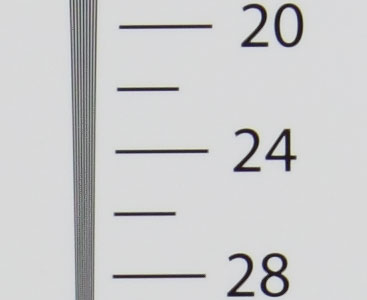 | 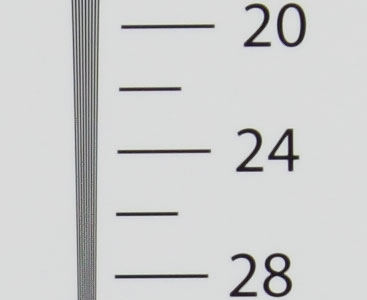 | |
2450 lpph, 18-200mm at 35mm, f8, 100 ISO | 2500 lpph, 17-85mm at 35mm, f8, 100 ISO | |
Canon EF-S 18-55mm IS with Canon EOS 50D | Canon EF 85mm f1.8 with Canon EOS 50D | |
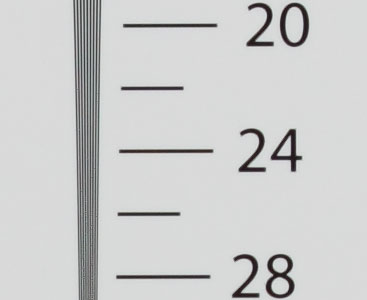 | 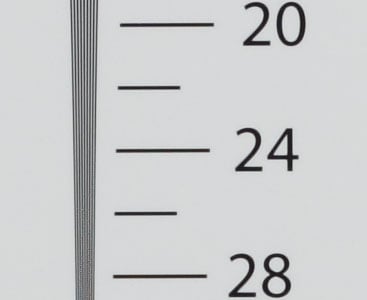 | |
2550 lpph, 18-55mm at 35mm, f8, 100 ISO | 2550 lpph, 85mm at f8, 100 ISO | |
Vertical resolution using Canon EOS 50D in RAW
Canon EF-S 18-200mm IS with Canon EOS 50D | Canon EF-S 17-85mm IS with Canon EOS 50D | |
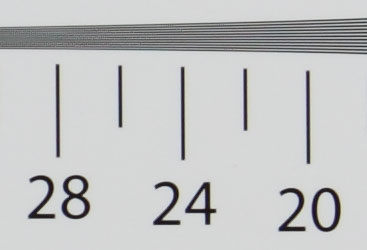 | 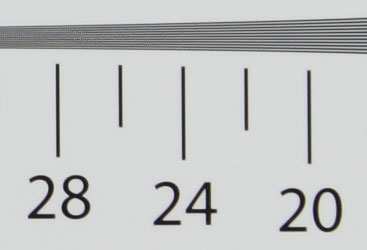 | |
2400 lpph, 18-200mm at 35mm, f8, 100 ISO | 2500 lpph, 17-85mm at 35mm, f8, 100 ISO | |
Canon EF-S 18-55mm IS with Canon EOS 50D | Canon EF 85mm f1.8 with Canon EOS 50D | |
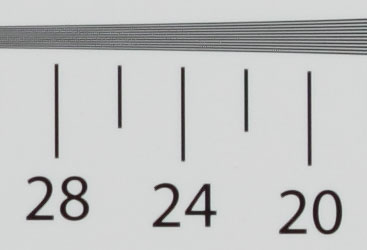 | 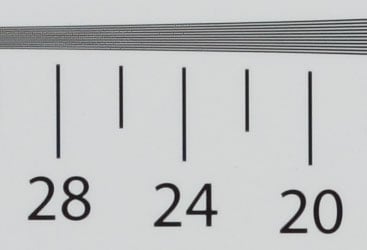 | |
2500 lpph, 18-55mm at 35mm, f8, 100 ISO | 2550 lpph, 85mm at f8, 100 ISO | |
To measure the Canon EF-S 18-200mm IS’s geometric distortion, we photographed a chart consisting of a grid pattern with the lens set to its shortest and longest focal lengths at an aperture of f8. The images were shot in RAW mode to avoid any in-camera corrections, then analysed with Imatest using 5th Order line calculation, and the full areas presented here at a reduced resolution. Smaller percentages are better. Results for rival lenses are shown at the bottom of this page; note the results for the EF-S 18-55mm here are for the older non-IS version.
With the Canon EF-S 18-200mm IS zoomed-out to 18mm, barrel distortion was measured at a fairly significant 6%. This is approximately twice as bad as the EF-S 18-55mm, EF-S 17-55mm IS and the EF 24-105mm IS (on a cropped body) when all are zoomed-out to their widest focal lengths. It’s also slightly worse than the 5.71% scored by the EF-S 17-85mm IS when zoomed-out. In reality, this means straight lines towards the edges of the frame, such as the edges of buildings or a horizon, can become quite distorted when zoomed-out. If you’re used to the EF-S 17-85mm IS, then you won’t notice much difference here, but it’s comfortably more pronounced than many other lenses. When zoomed-into 200mm, the EF-S 18-200mm IS, pincushion distortion was measured at 1.2%, which is slightly worse than the scores from the EF-S 17-85mm IS and EF-S 17-55mm IS. All three of these models exhibit noticeably worse distortion when zoomed-in compared to the EF-S 18-55mm and EF 24-105mm IS (on a cropped body). Again this means straight lines towards the edges of the frame when shooting with the lens zoomed-in can appear bent. So the Canon EF-S 18-200mm IS suffers from quite noticeable geometric distortion at both ends of its range, but particularly at wide angle. If you’re shooting portraits or natural landscapes, you may not notice, but precision architectural photographers will find it unsuitable. Pronounced geometric distortion is one of the compromises with having a super-zoom range, and for the record, the Nikkor DX 18-200mm VR was no angel in this respect either, with measurements of 5.26% barrel distortion at 18mm and 1.22% pincushion at 200mm. Sigma and Tamron’s super-zoom models also suffer from similar levels of distortion. Now let’s see how the lenses compare in terms of light fall-off in the corners in our Canon EF-S 18-200mm IS vignetting results. Canon EF-S 18-200mm Geometric distortion compared to other lenses
| |||||||||||||||||||||||||||||||||||||||||||||||||||
To measure the Canon EF-S 18-200mm IS’s vignetting and light fall-off we photographed a white target with a highly diffused custom filter. The lens was manually focused to infinity and tested at its shortest and longest focal lengths with its aperture wide open. The images were shot in RAW mode to avoid any in-camera corrections, then analysed with Imatest and the full areas presented here at a reduced resolution. This time, bigger percentages are better. Results for rival lenses are shown at the bottom of this page; note the results for the EF-S 18-55mm here are for the older non-IS version.
Zoomed-out to 18mm and with its aperture wide open, light falls-off in the corners of the frame to 37.7% of the centre measurement. This is significantly worse than any of the other lenses shown below, including the EF-S 17-55mm IS and EF-S 17-85mm IS which fell-off to 46.8% and 57.8% respectively. The bottom line here is darkening in the corners is quite apparent on the EF-S 18-200mm IS when zoomed-out, and you’ll even see it in the viewfinder when composing a shot which contains flat areas of colour like a blue sky. Zoomed-into 200mm with its aperture wide open, light falls-off in the corners to 41% of the centre measurement, which again is much worse than the other lenses compared below. The next worse of the group is the EF-S 17-55mm with 60.8% light fall-off when zoomed-in, but lest we forget, this is an optically bright lens with an f2.8 aperture, so it has a good excuse. The other three lenses score in the high seventies or low eighties. So once again, darkening in the corners is also apparent with the EF-S 18-200mm IS when zoomed-in. These are some of the worst scores we’ve measured for light fall-off on a lens which doesn’t have a bright focal ratio, and its super-zoom range can’t be used as an excuse either – after all, the Nikkor DX 18-200mm VR’s light fall-off was measured at 62.2% and 73.4% when zoomed-out and in respectively. It’s perhaps no coincidence then the EF-S 18-200mm IS was launched alongside Canon’s first body featuring in-camera peripheral illumination correction. With this feature enabled on the EOS 50D, we repeated the tests and measured light fall-off on in-camera JPEGs to be much more acceptable – indeed barely noticeable – at 82.5% and 85.1% when zoomed-out and in respectively. Peripheral illumination correction can also improve the results on all of Canon’s lenses, and luckily for those without the latest bodies, it can also be applied to RAW files using Canon’s Digital Photo Professional software. Bear in mind though the software is simply digitally brightening the corners, which in turn can reveal greater noise in these areas, especially if the shot was taken at higher sensitivities. But while light fall-off can now be corrected quite effectively after the event, the EF-S 18-200mm IS is still performing poorly in this test, and this is one aspect which cannot be blamed on its long optical range as similar models don’t suffer anywhere near as badly. That’s enough for our formal tests now, so let’s check out some more real-life sample images in our Canon EF-S 18-200mm IS Gallery. Canon EF-S 18-200mm Vignetting / Light fall-off compared to other lenses
| |||||||||||||||||||||||||||||||||||||||||||||||||||


